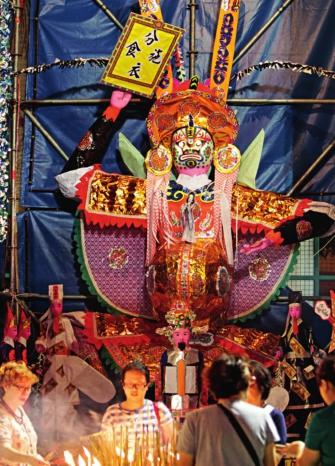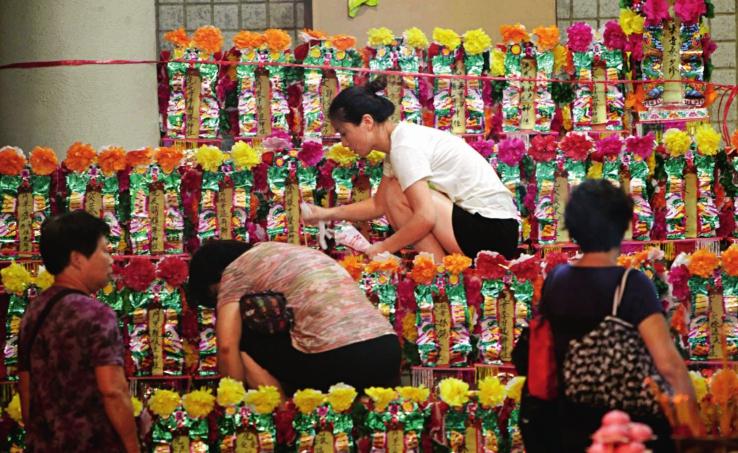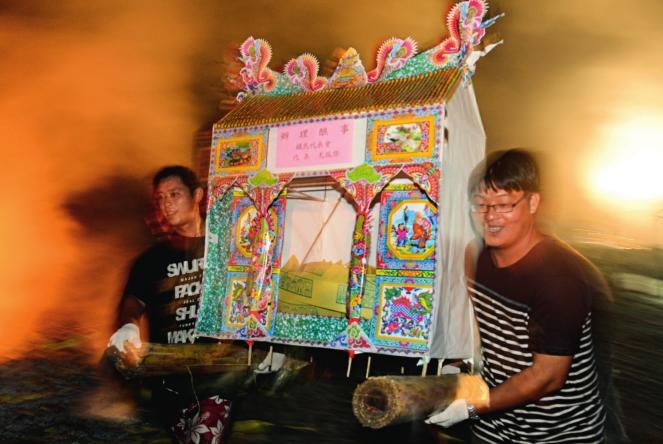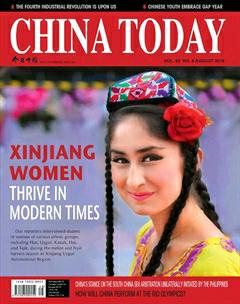Hong Kong’s Ullambana Festival:Chinese Halloween



DURING the seventh lunar month – around August – downtown Hong Kong is swathed in a haze of burning incense, and throbs to a hubbub of voices, sutra chants, and Chaozhou Opera music played on traditional stringed and woodwind instruments. All of these ingredients compose the Ullambana Festival, the traditional cultural event that Chaoshan residents brought to Hong Kong well over a century ago.
Established by migrants from the ChaozhouShantou region of Chinas mainland, the monthlong event was first observed in Hong Kongs Causeway Bay in 1897. It expressed these newcomers nostalgia for their old home and respect for their ancestors. It was also a way of enlivening the neighborhood. Later, the festival was held in other areas of Hong Kong, and the tradition carries on to this day. In 2011, the Ullambana Festival was added to the third batch of Chinas national intangible cultural heritage.
Forgiveness and Sacrifice
Also known as the Hungry Ghost Festival, Ullambana is held on the 15th day of the seventh lunar month. According to traditional folklore, this month, also known as Ghost Month, is when the gates to the underworld open for a month, allowing the departed to visit their families, feast, and roam the earth. Hong Kong people do their utmost to appease these transient ghosts while at the same time“feeding” their ancestors. It is one of Chinas main folk festivals.
Taoists call the Hungry Ghost Festival the Zhongyuan Festival, which is for them a celebration of the birthday of the Earth God. Taoist priests accordingly set up altars and chant sutras to celebrate this grand occasion. Ghosts leave the underworld and devotees offer sacrifices to pray for their an- cestors happiness in the afterlife, and also beg the Earth God to pardon their sins and let them enter heaven. This is a main reason why the festival is a folk holiday.
The Ullambana Festival originates in a Buddhist legend. Mu Lian was a Buddhist disciple, but his mother, who was deeply sinful, was eventually reborn in the lower realm of Hungry Ghosts. Her son presented offerings of food to her, but in her mouth they transformed into raging flames. Buddha instructed Mu Lian to prepare for his deceased mother an extra place at the family dinner table on the 15th day of the seventh lunar month. Monks from 10 directions could then help him to feed her. People still follow this Buddhist rite by holding a memorial ceremony for wandering ghosts. Widely told in China, this Buddhist parable is intended to encourage people to be kind and practice filial piety, a sentiment echoed in traditional Chinese thought.

The Hungry Ghost Festival and the Ullambana Festival gradually integrated with the Han peoples belief in ghosts, and eventually became the grand folk festival at which to offer sacrifices and absolve others from guilt.
Customs in Various Regions
According to folk legend, the gates to the underworld open on the first day of the seventh lunar month. Ghosts then come to receive earthly sacrifices, such as wealth accruing from the burning of paper money, and return on the last day of the month. The seventh lunar month is consequently abundant in ghost-appeasing rituals.
Ancestor worship starts at noon of the festival. The Hungry Ghost Festival is as important an occasion in this respect as are the Tomb-sweeping Day in early spring and the Double Ninth Festival in autumn. On that day, each family prepares delectable dishes, and places seven pairs of chopsticks, seven wine cups, and one jug of wine on an old-fashioned square table, so to bless the familys health, safety, and prosperity. At night, family members bring firecrackers, joss paper, or paper money, and incense sticks. They find a secluded place near a riverside or pond and draw a circle with lime powder. Within it they burn joss paper, and set off firecrackers, and thus respectfully see their ancestors off to the nether world. With the advance of the times, people nowadays retain the sacrificial ritual only to cherish the memory of their forefathers.
Other regions observe conventions apart from those relating to ancestor worship, such as burning paper ingots. But floating river lanterns is the grandest and most picturesque.
Paper lanterns are floated on rivers and lakes to escort ghosts to paradise, or to be imminently reborn. These lotus-shaped lanterns are made of colored paper and contain oil lamps or lighted candles. When darkness falls, these glowing vessels bob on the waves like stars in the night sky. Whether or not a ghost has been saved is calculated according to how the lanterns float. One that swirls signifies that the ghost is entangled. One that sinks means that the ghost has been rescued and reincarnated as a new baby. If the lantern floats faraway or approaches the shore, it means the ghost has arrived at the other world and become an immortal.
People of southern Fujian and Taiwan make river lanterns in the shape of palaces. Inside the palace is a triangular paper flag on which is written their ancestors name and honorific, to help ghosts find their family members. People in Jiangsu float four paper boats, one for hungry ghosts who spit fire, one to pray to Buddha, one to burn silver paper and ingots, and one on which to float lotus lanterns. People in Shanghai decorate these boats with red and green paper lanterns. Those most spectacular are launched by people in Shanxi. Regardless of age or sex, all gather along the Yellow River to float colorful lanterns. The children gaze at them to see how far they will go, while the adults pray.
The Ullambana Festival in Hong Kong
There are now 1.2 million residents of Hong Kong who are Chaoshan descendants and maintain the month-long Ullambana Festival tradition. It consists of ritual ceremonies, such as burning paper money and making sacrificial offerings of rice for safety, as well as of wine and meat, and drama performances. The festival takes place at more than 60 sites on Hong Kong Island, Kowloon, and the New Territories. At that time the sight of locals burning incense sticks and paper money on roads and in lanes to worship deceased relatives and release their souls from suffering is commonplace. At early morning, local communities are speckled with sacrificial offerings of rice and fruits. This simple ceremony links the temporal and nether worlds, and so pacifies hearts on both sides. Altars and religious rites are hence grand. People burn incense sticks to pray for their family members well-being, and the curling smoke from incense sticks carries their wishes and leaves them benedictions. These traditions have become a part of local peoples daily life.
These structures are generally in the form of bamboo sheds. Lanterns with streamers lead the way, to help ghosts find and enjoy tributes. The first bamboo shed houses the main altar, where Buddhist monks and nuns chant sutras for three days and nights to release souls from torment. The second one is to worship heaven, earth, and parents. It contains various decorative lights and offerings, and visitors are received on either flank. The third one enshrines the Boddishatva Avalokitesvara, whose infinite compassion is intended to inspire the hosts. There is also a blue-and-white stage on which to greet and escort ghosts away from the underworld. The largest shed is used to perform different dramas, in particular Chaozhou opera, for the free delectation of local residents.
At three pm, the ceremonial procession starts. Taoist priests first chant sutras. There follows a dance performance and the god-inviting rite. Participants sprinkle water along the road to expel bad luck, and some carry lanterns and red balls to lead the way. They invite and include the statues of gods from temples along the way and later return and place them at the altar. The entire procession is to the accompaniment of music and dance to pray for the neighborhoods safety.
Performances are for the amusement of gods as well as local residents, and last for three days from the 15th to the 17th. Originally, only Chaozhou shadow plays were shown, but shows are these days performed by theatrical troupes in praise of ancestors and to entertain the neighborhood.
Rice is dispensed during the ceremony. As Hong Kongs rice industry is mainly run by Chaoshan merchants, these offerings are given on the last day of the festival – not only to believers and the poor, but also to add blessings to ancestors. Daily necessities such as noodles and umbrellas are also distributed.
In addition to chanting sutras, there is also a Taoist rite to release souls from torment. Taoist priests scatter flowers to release wronged or troubled spirits, in hopes that observing how they bloom and fade will reflect lifes peaks and descents and so help the departed to accept their destiny.
The festival encompasses beautiful exhibits, festive lanterns, incense carved with flowers, Buddhist and Taoist activities, as well as performances. It is thus a carnival of Chinese worshipful traditions.
(Compiled and edited by China Today)

